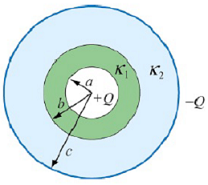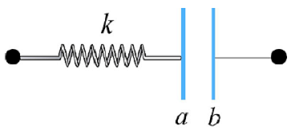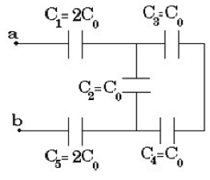Question 1: Consider a conducting spherical shell with an inner radius a and outer radius c. Let the space between two surfaces be filled with two different dielectric materials so that the dielectric constant is κ1 between a and b, and κ2 between b and c. The charge density of the inner shell is given by σ.

a) Calculate the surface charge density of the outer shell in terms of σ and other given constants.
b) Find the capacitance of the spherical capacitor.
c) Check what happens to the capacitance in the limit when κ1 and κ2 go to 1. Explain your result.
Question 2: Consider an air-filled parallel-plate capacitor with one plate connected to a spring having a force constant k, and another plate held fixed. The system rests on a table top as show n in the figure below.

If the charges placed on plates a and b are +Q and -Q , respectively, how much does the spring expand?
Question 3:
(a) A parallel-plate capacitor of area A and spacing d is filled with three dielectrics as shown in the figure below. Each occupies 1/3 of the volume. What is the capacitance of this system? [Hint: Consider an equivalent system to be three parallel capacitors, and justify this assumption.] Show that you obtain the proper limits as the dielectric constants approach unity, κi → 1.]

(b) This capacitor is now filled as shown in the figure below. What is its capacitance? Use Gauss's law to find the field in each dielectric, and then calculate ΔV across the entire capacitor. Again, check your answer as the dielectric constants approach unity. κi → 1. Could you have assumed that this system is equivalent to three capacitors in series?

Question 4: For the following network

With an applied potential Vab = V0. solve the following in terms of quantities given or subset thereof.
a) Find the equivalent capacitance between points a and b.
b) Calculate the charge on each capacitor.
c) Find the potential difference across each capacitor.
Boost up your academic grades with the most excellent Surface Charge Density Assignment Help service and stay ahead of the academic race..!!
Tags: Surface Charge Density Assignment Help, Surface Charge Density Homework Help, Surface Charge Density Coursework, Surface Charge Density Solved Assignments